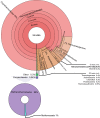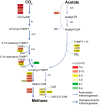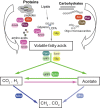Quantitative Metaproteomics Highlight the Metabolic Contributions of Uncultured Phylotypes in a Thermophilic Anaerobic Digester
- PMID: 27815274
- PMCID: PMC5203625
- DOI: 10.1128/AEM.01955-16
Quantitative Metaproteomics Highlight the Metabolic Contributions of Uncultured Phylotypes in a Thermophilic Anaerobic Digester
Abstract
In this study, we used multiple meta-omic approaches to characterize the microbial community and the active metabolic pathways of a stable industrial biogas reactor with food waste as the dominant feedstock, operating at thermophilic temperatures (60°C) and elevated levels of free ammonia (367 mg/liter NH3-N). The microbial community was strongly dominated (76% of all 16S rRNA amplicon sequences) by populations closely related to the proteolytic bacterium Coprothermobacter proteolyticus. Multiple Coprothermobacter-affiliated strains were detected, introducing an additional level of complexity seldom explored in biogas studies. Genome reconstructions provided metabolic insight into the microbes that performed biomass deconstruction and fermentation, including the deeply branching phyla Dictyoglomi and Planctomycetes and the candidate phylum "Atribacteria" These biomass degraders were complemented by a synergistic network of microorganisms that convert key fermentation intermediates (fatty acids) via syntrophic interactions with hydrogenotrophic methanogens to ultimately produce methane. Interpretation of the proteomics data also suggested activity of a Methanosaeta phylotype acclimatized to high ammonia levels. In particular, we report multiple novel phylotypes proposed as syntrophic acetate oxidizers, which also exert expression of enzymes needed for both the Wood-Ljungdahl pathway and β-oxidation of fatty acids to acetyl coenzyme A. Such an arrangement differs from known syntrophic oxidizing bacteria and presents an interesting hypothesis for future studies. Collectively, these findings provide increased insight into active metabolic roles of uncultured phylotypes and presents new synergistic relationships, both of which may contribute to the stability of the biogas reactor.
Importance: Biogas production through anaerobic digestion of organic waste provides an attractive source of renewable energy and a sustainable waste management strategy. A comprehensive understanding of the microbial community that drives anaerobic digesters is essential to ensure stable and efficient energy production. Here, we characterize the intricate microbial networks and metabolic pathways in a thermophilic biogas reactor. We discuss the impact of frequently encountered microbial populations as well as the metabolism of newly discovered novel phylotypes that seem to play distinct roles within key microbial stages of anaerobic digestion in this stable high-temperature system. In particular, we draft a metabolic scenario whereby multiple uncultured syntrophic acetate-oxidizing bacteria are capable of syntrophically oxidizing acetate as well as longer-chain fatty acids (via the β-oxidation and Wood-Ljundahl pathways) to hydrogen and carbon dioxide, which methanogens subsequently convert to methane.
Keywords: anaerobic digestion; metagenomics; metaproteomics; methane; microbial community.
Copyright © 2016 American Society for Microbiology.
Figures




Similar articles
-
Syntrophic Acetate-Oxidizing Microbial Consortia Enriched from Full-Scale Mesophilic Food Waste Anaerobic Digesters Showing High Biodiversity and Functional Redundancy.mSystems. 2022 Oct 26;7(5):e0033922. doi: 10.1128/msystems.00339-22. Epub 2022 Sep 8. mSystems. 2022. PMID: 36073802 Free PMC article.
-
Syntrophic acetate oxidation replaces acetoclastic methanogenesis during thermophilic digestion of biowaste.Microbiome. 2020 Jul 3;8(1):105. doi: 10.1186/s40168-020-00862-5. Microbiome. 2020. PMID: 32620171 Free PMC article.
-
Novel Syntrophic Populations Dominate an Ammonia-Tolerant Methanogenic Microbiome.mSystems. 2016 Sep 13;1(5):e00092-16. doi: 10.1128/mSystems.00092-16. eCollection 2016 Sep-Oct. mSystems. 2016. PMID: 27822555 Free PMC article.
-
Upflow anaerobic sludge blanket reactor--a review.Indian J Environ Health. 2001 Apr;43(2):1-82. Indian J Environ Health. 2001. PMID: 12397675 Review.
-
Ethanol-mediated Anaerobic Digestion: Functional Bacteria and Metabolic Pathways.Chemosphere. 2024 Nov;367:143560. doi: 10.1016/j.chemosphere.2024.143560. Epub 2024 Oct 18. Chemosphere. 2024. PMID: 39426748 Review.
Cited by
-
The effect of temperature and retention time on methane production and microbial community composition in staged anaerobic digesters fed with food waste.Biotechnol Biofuels. 2017 Dec 14;10:302. doi: 10.1186/s13068-017-0989-4. eCollection 2017. Biotechnol Biofuels. 2017. PMID: 29255485 Free PMC article.
-
Exploring the mechanisms of supplemented CO2 in enhancing methane production in anaerobic digestion process, a review.Bioengineered. 2025 Dec;16(1):2531667. doi: 10.1080/21655979.2025.2531667. Epub 2025 Jul 22. Bioengineered. 2025. PMID: 40693843 Free PMC article. Review.
-
Integrative meta-omics in Galaxy and beyond.Environ Microbiome. 2023 Jul 7;18(1):56. doi: 10.1186/s40793-023-00514-9. Environ Microbiome. 2023. PMID: 37420292 Free PMC article.
-
Anaerobic digestion of pig manure supernatant at high ammonia concentrations characterized by high abundances of Methanosaeta and non-euryarchaeotal archaea.Sci Rep. 2017 Nov 8;7(1):15077. doi: 10.1038/s41598-017-14527-1. Sci Rep. 2017. PMID: 29118356 Free PMC article.
-
Dynamics of a Perturbed Microbial Community during Thermophilic Anaerobic Digestion of Chemically Defined Soluble Organic Compounds.Microorganisms. 2018 Oct 11;6(4):105. doi: 10.3390/microorganisms6040105. Microorganisms. 2018. PMID: 30314333 Free PMC article.
References
-
- Zabranska J, Stepova J, Wachtl R, Jenicek P, Dohanyos M. 2000. The activity of anaerobic biomass in thermophilic and mesophilic digesters at different loading rates. Water Sci Technol 42:49–56.
Publication types
MeSH terms
Substances
LinkOut - more resources
Full Text Sources
Other Literature Sources
Molecular Biology Databases

